

Today we’re going to look at the covered call option payoff graph. This is designed for beginners so they can develop a basic understanding how to read the payoff graphs.
We’ll look at:
Contents
- Covered Call Option Basics
- Covered Call Option Payoff Graph
- Different Scenarios At Expiration
- Payoff Graph At Interim Dates
- How Changes In Volatility Impact The Payoff Graph
- Covered Call Option Payoff Summary
Covered Call Option Basics
A covered call is one of the easiest option trades and a great place for beginners to start their learning journey.
A covered call refers to a call option seller who also owns an equivalent amount of the underlying security. Remember that 1 option contract represents 100 shares.
To execute this, the investor sells call options on that same asset to generate an income stream.
His long position in the asset is the “cover” because it means he can deliver the shares if the buyer of the call option chooses to exercise.
What this means is that up until the contract expires, the seller of a call has the obligation to sell the stock at the agreed price.
Covered Call Option Payoff Graph
Understanding payoff graphs (or diagrams as they are sometimes referred) is absolutely essential for option traders.
A payoff graph will show the option position’s total profit or loss (Y-axis) depending on the underlying price (x-axis).
Here is an example:
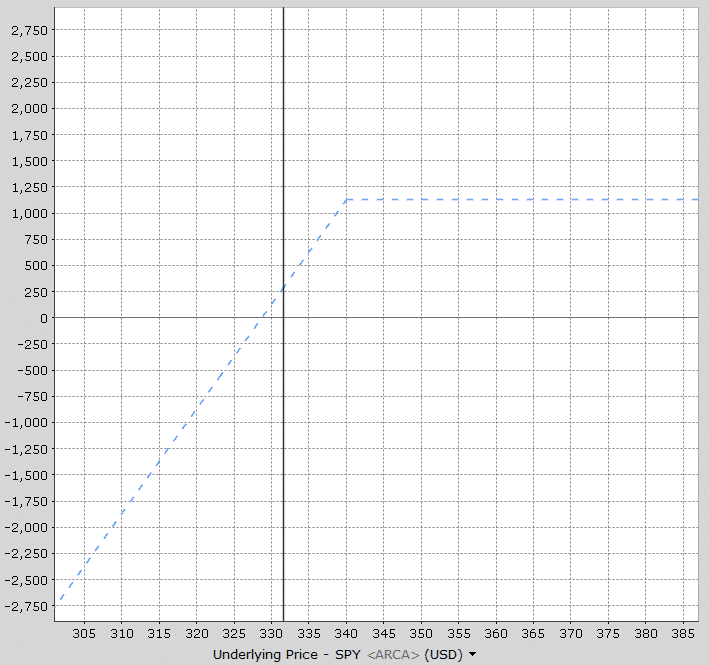
What we are looking at here is the payoff graph for a covered call option strategy.
In this example the trader has 100 shares of the underlying bought at $331.50 per share and sold a 340 strike call for $3 per contract (or $300 for a standard option contract representing 100 shares).
The maximum profit is equal to the short call strike, less the stock purchase price, plus the premium received.
That occurs at an underlying stock price of $340 and above. In this case the maximum profit is:
![]()
Below the strike price of 340, the line slopes downward as the payoff falls in proportion with the stock price.
The lines crosses into loss at a certain point when the stock price falls below the breakeven point.
The breakeven point is simply the stock purchase price minus the premium received. In this case it would be:
![]()
If the premium received had been slightly higher at $5, then the breakeven price would be $326.50.
Different Scenarios At Expiration
Four different scenarios can occur at expiration for a covered call trade.
1. Underlying stock price is above the strike price
If the underlying stock price is above the strike price at expiration, the call option will be in-the-money and assigned to sell the underlying shares.
The profit for the trade will be equal to the premium received plus the difference between strike price and share bought price.
In our example, this would be $3 per contract plus $340 – $331.5 per share or $1,150in total.
If the stock is trading above $340 at expiry, the trader’s profit is capped at $1,150 and he would miss out on any further upside in the stock.
2. Underlying stock price is equal to the strike price
The stock price ending right at the strike price at expiration would be incredibly rare, but it could happen.
In this case it doesn’t make sense for the opposite party (the buyer) to exercise the option because he could just buy the stock in the market for the same price without having to pay the exercise fees.
This is the ideal scenario for the trader where he keeps the premium and the 100 long shares and the share price rose to the maximum limit in his case.
3. Underlying stock price is below the purchase price but above the breakeven price
If the stock is below the purchase price at expiration, the trader may think he has a loss, but unless it gets below the breakeven price, it will not end in a loss.
For example, let’s say the stock ends at $330. The trader’s long position has a $1.5 of loss, but the $340 strike short call option expired worthless.
The $1.50 of loss is less than the $3 premium received, so in this scenario, even though the long stock position has a loss, the trader has a profit $1.50 per share.
This is also a favourable scenario for the trader where he keeps the 100 long shares and is still in profit even though the share price fell.
4. Underlying stock price is below the breakeven price
If the underlying stock price is below the breakeven price at expiration, the covered call option will result in a loss.
The loss for the trade will be equal to the ending stock price minus the stock purchase price plus the call option premium received.
Let’s assume the stock finished at $320, the loss is equal to $320 – $331.50 + $3 = $8.50 per share.
The bad thing about a covered call is that the loss is unlimited, the lower the price falls, the higher the loss in a linear fashion.
The premium received acts as a small buffer for a falling stock price and a covered call seller will always lose slightly less than an investor who only buys the stock.
Payoff Graph At Interim Dates
So far, we’ve only considered the payoff graph at expiration. The payoff graph at interim dates will look very different and will be impacted by factors such as time decay and implied volatility.
Calculating the profit and loss at expiration is quite simply, using excel or even in your head if you are half decent at maths.
Calculating profits and losses at interim dates is much more complex and requires more advanced software than just Excel.
Any decent options broker will have the ability to show option profits and losses at interim dates.
The below covered call option payoff is from Interactive Brokers.
The covered call option was an AAPL 110 strike call sold for $4.20 per contract or $420 in total and a long position bought at $106.10 per share.
The breakeven price at expiration is $101.90 (long position bought price minus premium received).
The blue line shows the expiration payoff that you are now familiar with and the purple line shows what is known as a “T+0” line.
T+0 simply means, what does the trade look like as of today?
Notice that the breakeven price as of today is the current AAPL price. This makes sense because we just sold the call so wouldn’t expect to have made or lost any money yet.

Notice also that losses occur before the expiration breakeven price and above 110, the profits are not the maximum profit.
As time goes by, the interim line slowly moves towards the expiration line.
Here’s how the payoff diagram is estimated to look at one week before expiration.
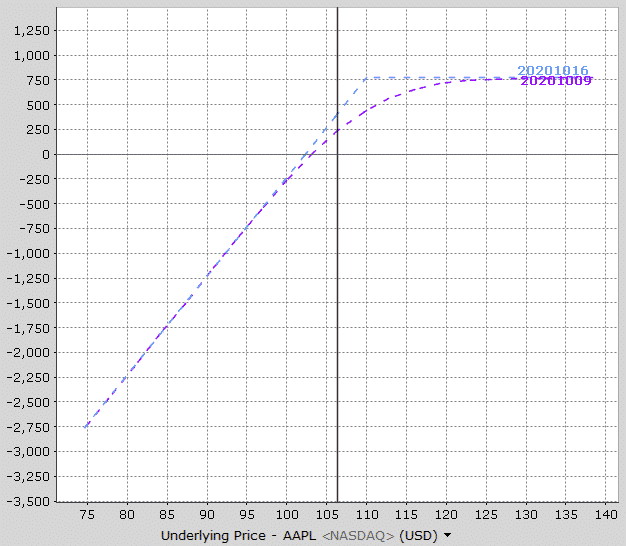
See how the purple line is now much closer to the expiration payoff line?
Most brokers will be able to provide this sort of graphical information for you.
I also like to use Option Net Explorer because they can show multiple interim date lines.
Looking at the payoff graph below, notice that there are three interim lines – T+0, T+7 and T+15. This gives the trader a good appreciation of how the trade will progress over time after 7 days and 15 days.
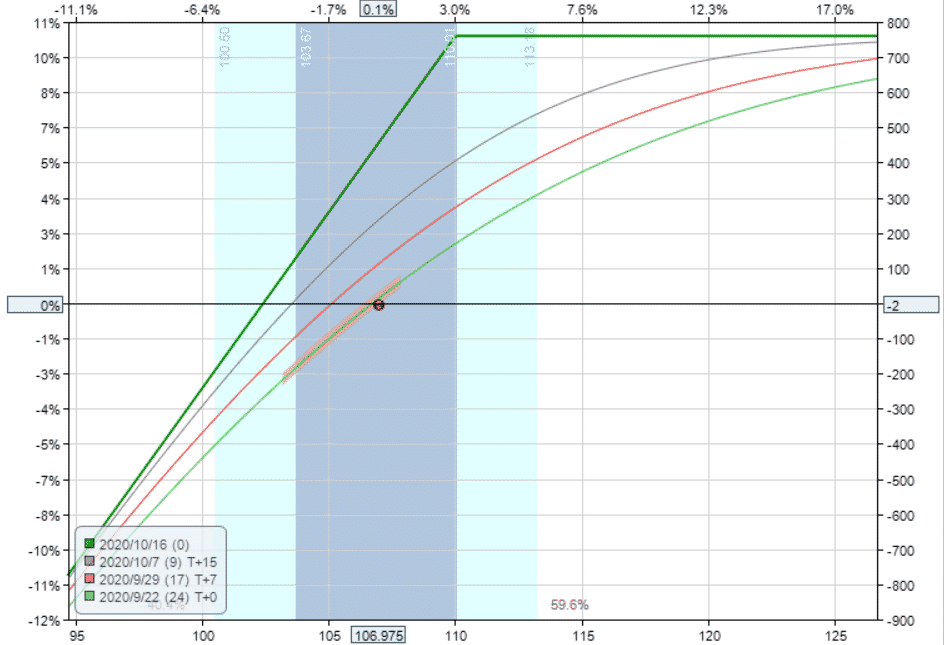
How Changes In Volatility Impact The Payoff Graph
Changes in implied volatility will not have any impact on the payoff graph at expiration, but it will impact the interim dates.
A covered call strategy has negative vega, meaning that it will benefit from an decrease in implied volatility after placing the trade.
This AAPL trade example has vega of -11 which means that for every 1% drop in implied volatility, the trade will make $11 with all other factors being equal.
The opposite is true if implied volatility rises.
Let’s take a look at how a 20% drop in volatility impacts the interim lines.
Notice that the expiration line hasn’t changed at all, but the interim lines have all moved higher.
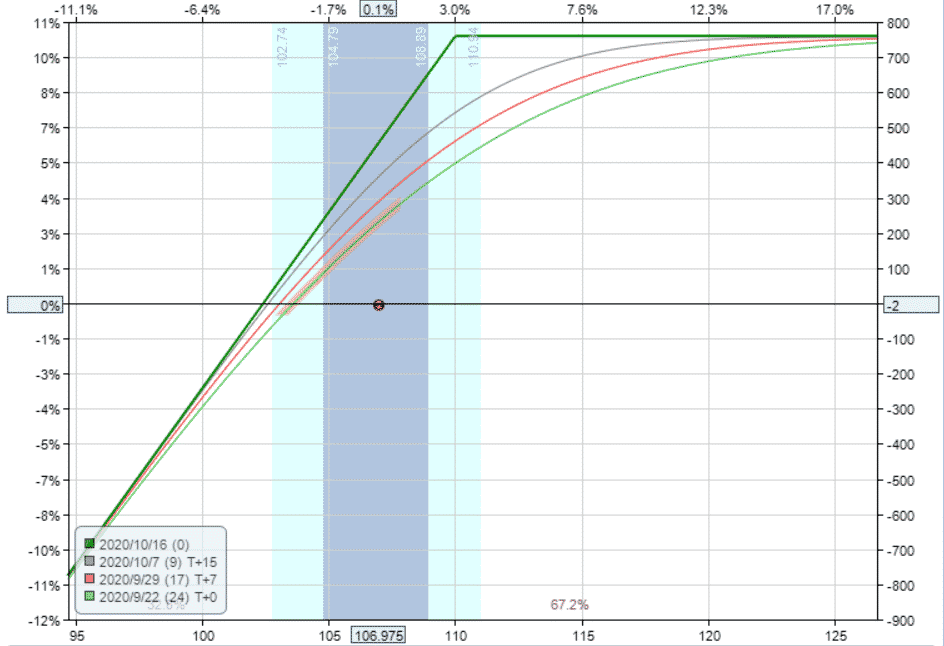
Now, let’s see how the diagram changes assuming a 20% rise in volatility. All the interim lines have dropped significantly.
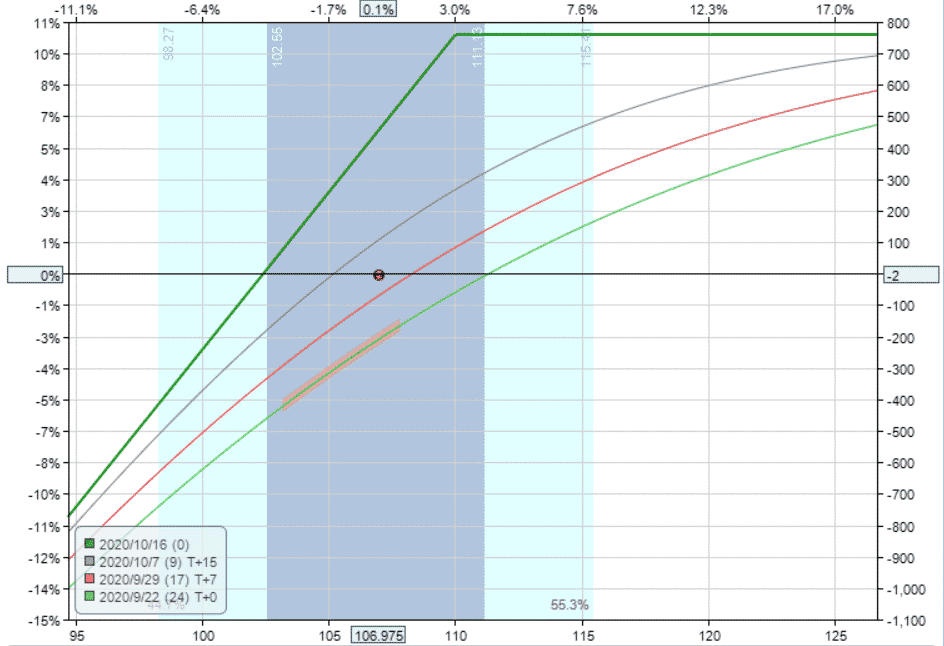
With a covered call strategy, delta is the main driver of the trade, but we can clearly see that big changes in implied volatility will also affect the trade.
Covered Call Option Payoff Summary
You should now be intimately familiar with the covered call option payoff graph. Let’s summarize some key points.
- Covered call options are a neutral and bullish strategy with limited upside and unlimited risk
- The maximum profit is equal to the premium received plus strike price minus the stock purchase price
- The breakeven price is equal to the stock purchase price price minus the premium received
- The position will gain value as expiration approaches due to time decay
- As a negative vega trade, a decrease in implied volatility will help the trade, but only at interim dates
If you’re still having trouble or want to learn more about these concepts, you can check out this 12,000 word beginners guide to options.
Trade safe!
Disclaimer: The information above is for educational purposes only and should not be treated as investment advice. The strategy presented would not be suitable for investors who are not familiar with exchange traded options. Any readers interested in this strategy should do their own research and seek advice from a licensed financial adviser.










